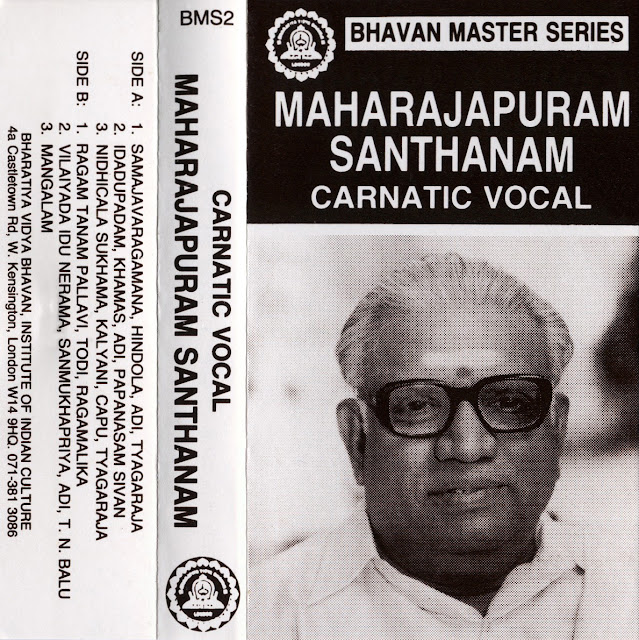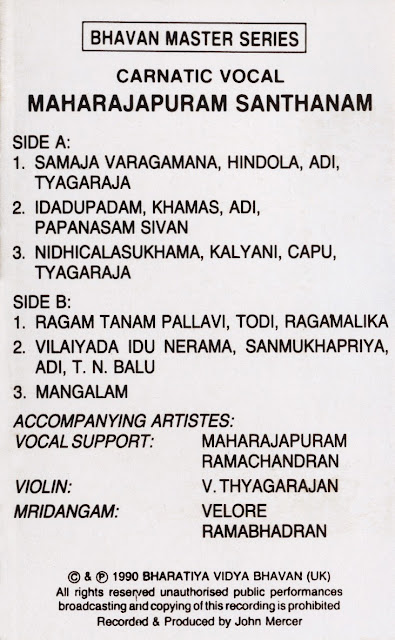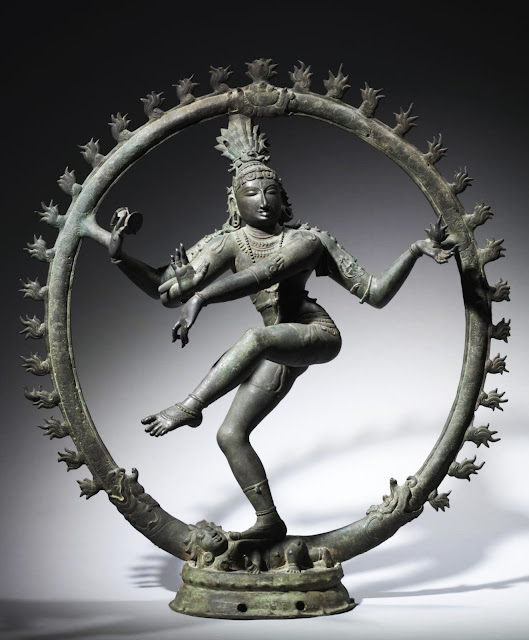INDIA – INDE
Maharajapuram Santhanam – Carnatic Vocals – Bharatiya Vidya Bhavan – Bhavan Master Series BMS2, released 1990 (Cassette)
Maharajapuram Santhanam (1928-1992) was one of the finest Carnatic vocalists of the second half of the 20th century. Born into a family of distinguished musicians in the village of Sirunangur, Tamil Nadu, Santhanam was mentored by his father, the renowned Carnatic vocalist Maharajapuram Viswanatha Iyer (1896-1970), and perfected his art under the guidance of Melattur Sama Dikshitar. In addition to vocals, Santhanam also mastered the veena and traditional dance. With his growing popularity on the Indian music scene, thanks to his many live concerts, All India Radio broadcasts and compositions, Santhanam received many accolades and had achieved great fame by the early 1970s. He died tragically in a car accident in 1992 at the age of 64. His disciples, including Dr R Ganesh (b. 1968) and his sons Ramachandran and Srinivasan now keep his tradition alive.
This excellent cassette of live recordings showcases Santhanam’s deep, mellifluous baritone voice and impeccable vocal phrasing effortlessly expressing emotion, sensuality, creativity, devotion and lofty ideals.
He is accompanied here by his son Maharajapuram Ramachandran on backing vocals, V. Thyagarajan (b. 1927) on violin and Velore G. Ramabhadran (1929-2012) on mridangam.
Maharajapuram Santhanam (1928-1992) fut l'un des plus grands chanteurs Carnatic de la seconde moitié du XXe siècle. Né dans une famille de musiciens de renom dans le village de Sirunangur, au Tamil Nadu, Maharajapuram Santhanam fut le disciple de son père, le célèbre chanteur Carnatic Maharajapuram Viswanatha Iyer (1896-1970), et perfectionna son art sous la tutelle de Melattur Sama Dikshitar. Outre le chant, Santhanam maîtrisa également la veena et la danse traditionnelle. Au fil de ses nombreux concerts et compositions, et des diffusions de sa musique sur All India Radio, sa renommée ne fit que grandir sur la scène musicale Indienne et prit une toute autre dimension à partir du début des années 1970. En 1992, il meurt tragiquement dans un accident de voiture à l'âge de 64 ans. Ses disciples, notamment Dr. R. Ganesh (né en 1968) et ses fils Ramachandran et Srinivasan, perpétuent aujourd'hui la tradition.
Cette excellente cassette de musique live présente sa voix de baryton profonde et mélodieuse, ainsi que son phrasé vocal impeccable, qui expriment avec maestria l'émotion, la sensualité, la créativité, la dévotion et des sentiments de noble plenitude.
Il est accompagné ici par son fils Maharajapuram Ramachandran en soutien vocal, V. Thyagarajan (né en 1927) au violon et Velore G. Ramabhadran (1929-2012) au mridangam.
Download:
Many thanks to our friend D. who spontaneously offered to share some of his favorite Indian Carnatic and Hindustani cassette tapes that he had digitized, including this rare album.
Our other Carnatic vocal music posts:
M. D. Ramanathan – HMV 7 EPE 1646 here
Balamuralikrishna – HMV 7 EPE 1617 here
M. S. Subbulakshmi – Meera Bhajans – EALP 1297 here
The Great Tradition – HMV EALP 1452 that includes a track by his father Maharajapuram Viswanatha Iyer here which you can listen to below:
Photographs below are from collections of the Cleveland Museum of Art here and the National Museum, New Delhi here
Nataraja, Shiva as the Lord of Dance, Tamil Nadu, 113 x 102 x 30 cm, Chola period c.1000:
“One of the most celebrated sculptural forms in the history of Indian art, this elegant and dynamic figure embodies some of Hinduism’s most fundamental tenets. According to Hindu thought, time is cyclical; the world is created, maintained, preserved for a time, then destroyed, only to be created again an infinite number of times. For those Hindus who view Shiva to be the all-powerful creator divinity, he is responsible for both creation and destruction. The ring of fire and the tongue of flame he holds in his left hand refer to destruction, and the drum in his raised right hand refers to the relentless beat of time as it moves inevitably forward. His lower right hand, held up with the palm facing out, signals to his devotees not to be afraid of the impending destruction; they can be liberated from the cycles of birth and death through devotion to him, which he indicates by pointing to his upraised foot. With every step in his dance, he lands on a dwarfish figure personifying ignorance.”
Manikkavachakar, Tamil Nadu, Late Chola period, 12th century;
The 9th century Tamil poet-saint, devoted his life to Lord Shiva and composed a collection of popular Tamil devotional hymns about his visions of the deity.
Please help me purchase important traditional records
to pursue my global curation project and
share the best finds with you on this blog:




just discovered your site and am in love. at first I assumed it was dead as most sites like this are. but nope! you're still going strong. thanks for all of your hard work. I want to download everything! literally. I notice everything is on Google Drive. Is it possible to share an general GDrive link so I could download things more efficiently? instead of going to each post and opening the GDrive link and then clicking the download button and then the yes definitely download button. if not, I understand.
ReplyDeleteExcellent! Thank-you.
ReplyDelete